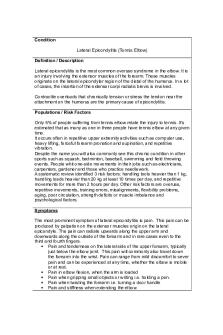Fractured Ulna - clinical pattern sheet PDF

| Title | Fractured Ulna - clinical pattern sheet |
|---|---|
| Course | Essentials of Musculoskeletal Physiotherapy |
| Institution | University of the West of England |
| Pages | 3 |
| File Size | 151.2 KB |
| File Type | |
| Total Downloads | 94 |
| Total Views | 158 |
Summary
clinical pattern sheet...
Description
Condition Fractured Ulna Definition / Description -
Break or crack in the longer of the 2 forearm bones. Classified as open or closed – punctured or broken skin?
Populations / Risk Factors -
Trauma Specific sports where blunt force/collisions may occur Those with weak/brittle bones (osteoporosis) – post-menopausal women Elderly – risk from falls, put hands out
Symptoms -
Localized pain on medial aspect of forearm, tenderness and swelling at fracture site Sudden onset of pain Pain can occasionally settle quickly leaving patients with a localized ache that is particularly prominent at night or first thing in the morning Swelling Bruising Pain may increase with twisting of forearm, gripping or weight baring e.g. pushing Occasionally pins and needles/numbness of forearm, hand or fingers Severe cases may present obvious deformity
Clinical Signs -
Examine wrist and elbow for ROM and tenderness Palpate wrist to evaluate for ulna styloid fracture
History -
History is usually consistent with a direct blow to the forearm or a fall directly onto the forearm or outstretched hand. Understanding the mechanism of injury helps direct the physical examination to detect injuries.
Investigations -
Physical examination
-
X-ray required to confirm diagnosis MRI, CT or bone scan may be required in some cases to assist with diagnosis and assess severity
Atypical Presentations -
Unlikely.
Management Options and Levels of Evidence Immediate treatment – temporary realignment of bones depending on severity, application of a splint and/or a sling. Applying ice to reduce swelling. Pain medication.
Nonsurgical treatment – cast or brace to stabilize arm. Frequent x-rays to monitor. If the fracture shifts position surgery may then be required. Surgical treatment – most likely if open fracture or both radius and ulna are fractured. Increased risk of infection means open fractures require immediate surgery. Antibiotics and sometimes tetanus required if open fracture. Open reduction and internal fixation with plates and screws – most common.
Open reduction and internal fixation with rods - specially designed metal rod is inserted through the marrow space in the center of the bone. External fixation - If the skin and bone are severely damaged, using plates and screws and large incisions may injure the skin further. metal pins or screws are placed into the bone above and below the fracture site. The pins
and screws are attached to a bar outside the skin. This device is a stabilizing frame that holds the bones in the proper position so they can heal. Long term – pain management. After 2-6 weeks’ physical therapy to initially increase ROM and reduce stiffness and build up to strengthening the muscles and surrounding structures if the fracture site. Useful Resources -
Slings Wrist braces Ice/heat packs Resistance band for rehab Stress ball type thing for rehab
http://orthoinfo.aaos.org/topic.cfm?topic=a00584 - useful link for more info....
Similar Free PDFs

Clinical Pattern sheet
- 10 Pages

Medial meniscus clinical pattern
- 3 Pages

COPD - clinical pattern sheets
- 2 Pages

Clinical brain sheet
- 1 Pages

Análisis de pelicula fractured
- 8 Pages

Pattern Comportamentali
- 23 Pages
Popular Institutions
- Tinajero National High School - Annex
- Politeknik Caltex Riau
- Yokohama City University
- SGT University
- University of Al-Qadisiyah
- Divine Word College of Vigan
- Techniek College Rotterdam
- Universidade de Santiago
- Universiti Teknologi MARA Cawangan Johor Kampus Pasir Gudang
- Poltekkes Kemenkes Yogyakarta
- Baguio City National High School
- Colegio san marcos
- preparatoria uno
- Centro de Bachillerato Tecnológico Industrial y de Servicios No. 107
- Dalian Maritime University
- Quang Trung Secondary School
- Colegio Tecnológico en Informática
- Corporación Regional de Educación Superior
- Grupo CEDVA
- Dar Al Uloom University
- Centro de Estudios Preuniversitarios de la Universidad Nacional de Ingeniería
- 上智大学
- Aakash International School, Nuna Majara
- San Felipe Neri Catholic School
- Kang Chiao International School - New Taipei City
- Misamis Occidental National High School
- Institución Educativa Escuela Normal Juan Ladrilleros
- Kolehiyo ng Pantukan
- Batanes State College
- Instituto Continental
- Sekolah Menengah Kejuruan Kesehatan Kaltara (Tarakan)
- Colegio de La Inmaculada Concepcion - Cebu









